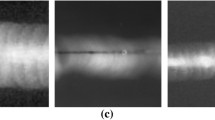Abstract
Ultrasonic signal classification of defects in weldment, in automatic fashion, is an active area of research and many pattern recognition approaches have been developed to classify ultrasonic signals correctly. However, most of the developed algorithms depend on some statistical or signal processing techniques to extract the suitable features for them. In this work, data driven approaches are used to train the neural network for defect classification without extracting any feature from ultrasonic signals. Firstly, the performance of single hidden layer neural network was evaluated as almost all the prior works have applied it for classification then its performance was compared with deep neural network with drop out regularization. The results demonstrate that given deep neural network architecture is more robust and the network can classify defects with high accuracy without extracting any feature from ultrasonic signals.
Similar content being viewed by others
References
S. J. Song and L. W. Schmerr, Ultrasonic flaw classification in weldments using probabilistic neural networks, Journal of Nondestructive Evaluation, 11 (2) (1992) 69–77.
A. Masnata and M. Sunseri, Neural network classification of flaws detected by ultrasonic means, NDT & E International, 29 (2) (1996) 87–93.
F. W. Margrave, K. Rigas, D. A. Bradley and P. Barrowcliffe, The use of neural networks in ultrasonic flaw detection, Measurement, 25 (2) (1999) 143–154.
R. Drai, M. Khelil and A. Benchaala, Time frequency and wavelet transform applied to selected problems in ultrasonics, NDE. NDT & E International, 35 (8) (2002) 567–572.
S. J. Song, H. J. Kim and H. Cho, Development of an intelligent system for ultrasonic flaw classification in weldments, Nuclear Engineering and Design, 212 (1) (2002) 307–320.
F. Cau, A. Fanni, A. Montisci, P. Testoni and M. Usai, Artificial neural networks for non-destructive evaluation with ultrasonic waves in not accessible pipes, Industry Applications Conference, 2005. Fourtieth IAS Annual Meeting (2005).
S. Sambath, P. Nagaraj and N. Selvakumar, Automatic defect classification in ultrasonic NDT using artificial intelligence, Journal of Nondestructive Evaluation, 30 (1) (2011) 20–28.
E. F. Simas Filho, M. M. Silva, P. C. Farias, M. C. Albuquerque, I. C. Silva and C. T. Farias, Flexible decision support system for ultrasound evaluation of fiber–metal laminates implemented in a DSP, NDT & E International, 79 (2016) 38–45.
F. C. Cruz, E. F. Simas Filho, M. C. Albuquerque, I. C. SIlva, C. T. Farias and L. L. Gouvêa, Efficient feature selection for neural network based detection of flaws in steel welded joints using ultrasound testing, Ultrasonics, 73 (2017) 1–8.
Y. LeCun, Y. Bengio and G. Hinton, Deep learning, Nature, 521 (7553) (2015) 436–444.
J. Schmidhuber, Deep learning in neural networks: An overview, Neural Networks, 61 (2015) 85–117.
A. Géron, Hands on machine learning with scikit-learn and tensorflow, O’Reilly, Media (2017).
G. E. Hinton, N. Srivastava, A. Krizhevsky, I. Sutskever and R. R. Salakhutdinov, Improving neural networks by preventing co-adaptation of feature detectors, arXiv preprint, p. arXiv:1207.0580 (2012).
N. Srivastava, G. E. Hinton, A. Krizhevsky, I. Sutskever and R. Salakhutdinov, Dropout: A simple way to prevent neural networks from overfitting, Journal of Machine Learning Research, 15 (1) (2014) 1929–1958.
V. Nair and G. E. Hinton, Rectified linear units improve restricted boltzmann machines, Proceedings of the 27th International Conference on Machine Learning (ICML-10) (2010).
A. L. Maas, A. Y. Hannun and A. Y. Ng, Rectifier nonlinearities improve neural network acoustic models, Proc. ICML, June (2013).
A. Krizhevsky, I. Sutskever and G. E. Hinton, Imagenet classification with deep convolutional neural networks, Advances in Neural Information Processing Systems (2012).
T. Rashid, Make your own neural network, CreateSpace Independent Publishing Platform (2016).
Author information
Authors and Affiliations
Corresponding author
Additional information
Recommended by Associate Editor Daeil Kwon
Sung-Jin Song obtained his Ph.D. in Engineering Mechanics from Iowa State University, Ames, Iowa, USA in 1991. He worked at Daewoo Heavy Industries, Ltd., in Incheon, Korea for five years since 1983 where he has been certified as ASNT Level III in RT, UT, MT and PT. He has worked at Chosun University, Gwangju, Korea as Assistant Professor for five years starting in 1993. Since 1998, he has been employed at Sungkyunkwan University, Suwon, Republic of Korea and is currently the Professor in Mechanical Engineering Department.
Hak-Joon Kim received his B.S. degree in Mechanical Engineering from Chosun University, Gwangju, Korea in 1995, his M.S. degree in Mechanical Engineering from Chosun University in 1997, and his Ph.D. in Engineering Mechanics from Sungkyunkwan University, Suwon, Korea in 2002. He worked at the Center for NDE at Iowa State University, Iowa USA for 2 years from 2002 as Post-Doctoral Researcher. Since 2005 he has been at Sungkyunwkan University and is currently Research Professor of Mechanical Engineering. His major research areas are Nondestructive evaluation for materials characteristics and structural integrity using ultrasound, eddy current and etc.
Nauman Munir is a Ph.D. candidate at Sungkyunkwan University (Suwon, Republic of Korea) in Mechanical Engineering Department. He received his M.Sc. in Mechanical Engineering from University of Engineering and Technology, Lahore, Pakistan. His field of interest includes Ultrasonics, Weldment flaws classification and Deep learning etc.
Rights and permissions
About this article
Cite this article
Munir, N., Kim, HJ., Song, SJ. et al. Investigation of deep neural network with drop out for ultrasonic flaw classification in weldments. J Mech Sci Technol 32, 3073–3080 (2018). https://doi.org/10.1007/s12206-018-0610-1
Received:
Revised:
Accepted:
Published:
Issue Date:
DOI: https://doi.org/10.1007/s12206-018-0610-1




